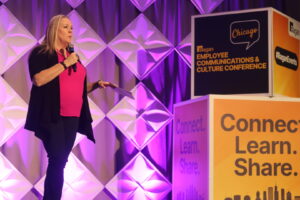Creating collaborative workspaces for the deskless worker with digital transformation
How organizations can ensure both their deskless employees are engaged and working together.

Even before the COVID-19 pandemic, organizations were already in the midst of a digital transformation. In 2020, deskless workers accounted for 2.7 billion, or 80% of the workforce worldwide. These are people working in agriculture, construction, retail, manufacturing and transportation who aren’t sitting at a desk, staring at a screen to perform their work. Despite that number, most technology has traditionally been designed for the office worker while the deskless have been regulated to pen-and-paper-based systems or feel they don’t have enough. In fact, 70% of deskless workers feel that more technology would help them do their jobs better. And the pandemic has changed things swiftly.
According to a recent McKinsey survey of global executives, organizations have advanced digitization adoption for customer and supply chain interfacing by three to four years in response to the pandemic and the now increasingly remote workforce. At the same time, they’ve also accelerated their digital or digitally enabled products by seven years. While some of these changes were temporary solutions to survive in a crisis, many respondents are expecting the changes to become permanent and are making investments to ensure they do.
MSL US and Harris Poll worked on a 2022 report on the true sources of employee influence to understand what has changed with water cooler talk. They found that much energy went into creating and sustaining engagement with remote workers during the pandemic and having regular access (desk-based) or lack of access (deskless) to technology-shaped water cooler moments at an organization more than was believed.
Desk-based workers are influenced by information and, unsurprisingly, the best way to reach these employees is through email (65%). For deskless workers, 41% say that internal communications do not have a big impact on how they think about their company. For deskless workers, word of mouth (54%) is the best way to reach out to them as they are influenced by individuals in their networks.
So how do organizations make sure both their desk-based and deskless employees are all engaged and working together? Some organizations are using a refined digital workspace that handles the communication and engagement needs of their organization today and sets them up strategically for success tomorrow. It’s a way for them to bring everyone together in an organization to collaborate, share information and have clear lines of communication.
Strategy for Setting the Digital Workspace
With software and technologies becoming readily available and accessible, the digital landscape has become vast. It would be hard to get away from needing multiple applications though as there are so many different needs in an organization — even software with combined capabilities can’t address everything. That’s why it’s important to find a way for your apps to play nicely together while creating an employee experience that creates true knowledge sharing, working between departments regardless of where your workers are based. But how do organizations set out to accomplish that?
“Customization is key,” says Lisa Claybon, vice president of communications at Compass Group North America & Chartwells K12. “What works for one organization may not work for another.” Compass rolled out an app-based service to several of its divisions. It allows for two-way communication and has been a powerful tool for the overall organization. “It’s not just pushing out official corporate messages but having fun and giving them a reason to engage and get excited about sharing what they’re doing on a day-to-day basis with each other.”
UK-based ClearBox Consulting’s Susie Robinson asserts that the process must begin with research. ClearBox starts by understanding what tools an organization needs in its digital platform, and they break things down between digital capabilities that can be incorporated across an Intranet platform (communication & engagement; collaboration; find & share; and business applications) and management areas that need to be considered for their tools to be a success (strategy; governance & operations; adoption; and user experience). That way, the platform is built out with the specific collaboration and communication needs of an organization, considering the overall strategy for the company but also what employees need as well.
“If we want our digital workplace to be our single source of truth, it’s really important that information that might live in other apps, like even in your chat apps, can be shared into your Intranet,” explains Mary Kaplan, product manager at LumApps during a recent Ragan webinar. “So if I start six months later and I need a piece of content, I don’t have to go to chat first. I know I can go to my intranet and search for it there, even though it originated in chat. So think about employee experience when you’re creating this digital workplace.”
A Tale of Two Companies
When supply chain service provider FM Logistic began its digital transformation, it decided to build a new digital workplace utilizing Google Workspace for productivity tools and LumApps for its intranet needs. Operating across 14 countries with a large part of its workforce deskless, the organization needed a central hub where its more than 27,500 employees could find all tools and information needed in one place with a mobile-first strategy in mind. FM Logistic launched its new platform in under six months, providing all employees personalized news feeds, easy access to all apps needed, in-app chat for centralized communications and simplifying the issue-reporting processes. FM Logistic’s intranet garners more than 1,300 content items per year in 14 languages and a 92% rate of active users.
Similarly, Schnucks Markets knew it needed to do something different when it turned to LumApps and its partner Agost for a new integrated digital platform. Until then, the organization relied primarily on email communications to communicate to over 14,000 employees at 113 supermarket locations across five states in the Midwest. It had no central hub of information leaving communications on branding, expansion and sales and incentive initiatives to get lost in a digital void.
By launching its new intranet “Schnucks Connection,” teammates can log into a single platform and find everything they need in place. With the new workspace, supervisors are able to autonomously distribute information and send quick updates for urgent announcements to all teammates in the store or remotely via their mobile devices. What Schnucks has seen is a reduction in email communications due to the more simplified centralization of information while teammates are more engaged at work and with their peers.
Utilizing a digital workspace that handles the communication and engagement needs of both deskless and desked employees, organizations can create a more efficient and collaborative workforce. But it will have to be built with the needs of the employees in mind and they should understand what’s in it for them.
“It’s important to have buy-in from the beginning as you’re making the decisions about what steps to take,” explains Claybon. “What are the expectations? Because driving something, especially if you’re asking people to use their own phone to tap into an app, you have to realize you’re not going to get 100% participation. It may not be the end all, be all that every single piece of communications can flow through but have everybody on board with what the expectations are and how it can truly be effective.”






